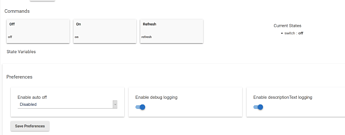Here is one for the loadless switches…
/**
* Intermatic CA5100
*
* Scottin Pollock
*/
metadata {
definition (name: "Intermatic CA5100", namespace: "scottinpollock.us", author: "Scottin Pollock") {
capability "Switch"
capability "Actuator"
capability "Indicator"
capability "Switch"
capability "Polling"
capability "Refresh"
capability "Sensor"
fingerprint inClusters: "0x25"
}
// simulator metadata
simulator {
status "on": "command: 2003, payload: FF"
status "off": "command: 2003, payload: 00"
// reply messages
reply "2001FF,delay 100,2502": "command: 2503, payload: FF"
reply "200100,delay 100,2502": "command: 2503, payload: 00"
}
// tile definitions
tiles {
standardTile("switch", "device.switch", width: 2, height: 2, canChangeIcon: true) {
state "on", label: '${name}', action: "switch.off", icon: "st.switches.switch.on", backgroundColor: "#79b821"
state "off", label: '${name}', action: "switch.on", icon: "st.switches.switch.off", backgroundColor: "#ffffff"
}
standardTile("indicator", "device.indicatorStatus", inactiveLabel: false, decoration: "flat") {
state "when off", action:"indicator.indicatorWhenOn", icon:"st.indicators.lit-when-off"
state "when on", action:"indicator.indicatorNever", icon:"st.indicators.lit-when-on"
state "never", action:"indicator.indicatorWhenOff", icon:"st.indicators.never-lit"
}
standardTile("refresh", "device.switch", inactiveLabel: false, decoration: "flat") {
state "default", label:'', action:"refresh.refresh", icon:"st.secondary.refresh"
}
main "switch"
details(["switch","refresh","indicator"])
}
}
def parse(String description) {
def result = null
def cmd = zwave.parse(description, [0x20: 1, 0x70: 1])
log.debug "my cmd was $cmd"
if (cmd) {
result = createEvent(zwaveEvent(cmd))
}
if (result?.name == 'hail' && hubFirmwareLessThan("000.011.00602")) {
result = [result, response(zwave.basicV1.basicGet())]
log.debug "Was hailed: requesting state update"
} else {
log.debug "My Parse returned ${result?.descriptionText}"
}
return result
}
// NEWLY ADDED METHOD BELOW
def zwaveEvent(physicalgraph.zwave.commands.basicv1.BasicSet cmd) {
log.debug "we got into BasicSet"
[name: "switch", value: cmd.value > 200 ? "on" : "off", type: "physical"]
}
//THAT'S IT
def zwaveEvent(physicalgraph.zwave.commands.basicv1.BasicReport cmd) {
[name: "switch", value: cmd.value ? "on" : "off", type: "physical"]
log.debug "we got into BasicReport"
}
def zwaveEvent(physicalgraph.zwave.commands.switchbinaryv1.SwitchBinaryReport cmd) {
[name: "switch", value: cmd.value ? "on" : "off", type: "digital"]
log.debug "we got into SwitchBinaryReport"
}
def zwaveEvent(physicalgraph.zwave.commands.configurationv1.ConfigurationReport cmd) {
log.debug "we got into ConfigurationReport"
def value = "when off"
log.debug cmd.configurationValue
if (cmd.configurationValue[0] == 1) {value = "when on"}
if (cmd.configurationValue[0] == 2) {value = "never"}
[name: "indicatorStatus", value: value, display: false]
}
def zwaveEvent(physicalgraph.zwave.commands.hailv1.Hail cmd) {
log.debug "we got into Hail"
[name: "hail", value: "hail", descriptionText: "Switch button was pressed", displayed: false]
}
def zwaveEvent(physicalgraph.zwave.commands.manufacturerspecificv2.ManufacturerSpecificReport cmd) {
log.debug "we got into ManufacturerSpecificReport"
if (state.manufacturer != cmd.manufacturerName) {
updateDataValue("manufacturer", cmd.manufacturerName)
}
}
def zwaveEvent(physicalgraph.zwave.Command cmd) {
log.debug "we got into Command"
// Handles all Z-Wave commands we aren't interested in
[:]
}
def on() {
sendEvent(name: "switch", value: "on")
delayBetween([
zwave.basicV1.basicSet(value: 0xFF).format(),
zwave.switchBinaryV1.switchBinaryGet().format()
])
}
def off() {
sendEvent(name: "switch", value: "off")
delayBetween([
zwave.basicV1.basicSet(value: 0x00).format(),
zwave.switchBinaryV1.switchBinaryGet().format()
])
}
def poll() {
delayBetween([
zwave.switchBinaryV1.switchBinaryGet().format(),
zwave.manufacturerSpecificV1.manufacturerSpecificGet().format()
])
}
def refresh() {
delayBetween([
zwave.switchBinaryV1.switchBinaryGet().format(),
zwave.manufacturerSpecificV1.manufacturerSpecificGet().format()
])
}
def indicatorWhenOn() {
log.debug "we got into indicatorWhenOn"
sendEvent(name: "indicatorStatus", value: "when on", display: false)
zwave.configurationV1.configurationSet(configurationValue: [1], parameterNumber: 3, size: 1).format()
}
def indicatorWhenOff() {
sendEvent(name: "indicatorStatus", value: "when off", display: false)
zwave.configurationV1.configurationSet(configurationValue: [0], parameterNumber: 3, size: 1).format()
}
def indicatorNever() {
sendEvent(name: "indicatorStatus", value: "never", display: false)
zwave.configurationV1.configurationSet(configurationValue: [2], parameterNumber: 3, size: 1).format()
}
def invertSwitch(invert=true) {
if (invert) {
zwave.configurationV1.configurationSet(configurationValue: [1], parameterNumber: 4, size: 1).format()
}
else {
zwave.configurationV1.configurationSet(configurationValue: [0], parameterNumber: 4, size: 1).format()
}
}



